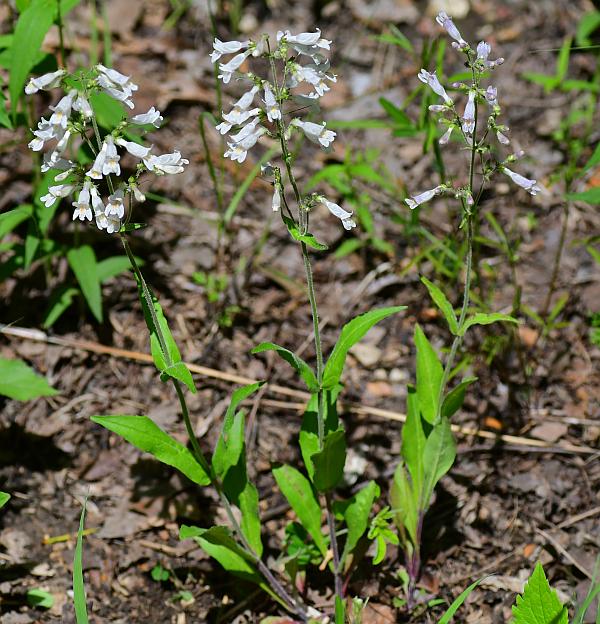Penstemon pallidus Small
Pale Beardtongue

Native
CC = 5
CW = 5
MOC = 78
© SRTurner
Penstemon pallidus SmallPale Beardtongue | |
 |
Native CC = 5 CW = 5 MOC = 78 |
© SRTurner |
|
Family - Plantaginaceae Habit - Perennial forb from small caudex and taproot. Stems - Ascending to erect, to 60 cm, simple, sometimes multiple from base, densely pubescent with minute, nonglandular hairs, also with moderate to dense, longer, glandular hairs, green to grayish green, not glaucous.
Leaves - Basal and opposite. Basal leaves 2-12 cm long, oblanceolate to spatulate, rounded to bluntly pointed at the tip, tapered basally to a usually winged petiole, the margins entire or toothed, the surfaces moderately to densely pubescent with shorter nonglandular and longer glandular hairs, sometimes mostly along the margins and main veins, not glaucous. Stem leaves 2-10 cm long, the lowermost with the blade oblanceolate to narrowly oblong-elliptic or narrowly ovate, grading into lanceolate near the stem tip, bluntly to sharply pointed at the tip, sessile or nearly so, the base of the lower blades tapered, grading through rounded to those of the uppermost leaves usually shallowly cordate and clasping, the margins entire or toothed, at least above the midpoint, the surfaces pubescent with shorter nonglandular and longer glandular hairs, sometimes mostly along the margins and main veins, not glaucous.
Inflorescences - Terminal pyramidal panicles, the central axis densely glandular-hairy, green to grayish green, not glaucous, with 3-8 nodes, each with a pair of relatively small, linear to narrowly lanceolate, somewhat clasping bracts, the branches loosely to strongly ascending or arched upward, with a pair of few- to several-branched clusters per node, each main branch with 2-9 flowers.
Flowers - Calyces 3-5 mm long at flowering, densely glandular-hairy, not glaucous, the lobes ovate. Corollas 17-23 mm long, the tube abruptly but relatively slightly enlarged near the midpoint, strongly bilabiate, the upper lip 2-lobed, spreading to somewhat recurved, the lower lip 3-lobed, slightly spreading to nearly straight, white or occasionally pale pinkish-to purplish-tinged, the throat appearing slightly flattened, relatively strongly 2-ridged and usually lined with purple nectar guides on the lower side, minutely glandular-hairy externally and sparsely to moderately nonglandular-hairy in the throat. Staminode white, strongly flattened toward the tip, white-hairy on the upper surface, slightly curved downward apically and bearded with yellow hairs. Stamens 4, adnate at base of corolla tube. Filaments to 2 cm long, glabrous. Anthers brown, 2 mm long. Style 1, included, glabrous, filiform, 1.3 cm long. Ovary green, glabrous, superior, 2.1 mm long, ovoid-conic, 2-locular. Placentation axile.
Fruits - Capsules 5-7 mm long. Seeds 0.5-0.8 mm long, brown to dark brown, the tan to reddish brown ridges usually poorly developed. Flowering - April - July. Habitat - Glades, ledges and tops of bluffs, upland prairies, savannas, openings of dry upland forests, pastures, fields, quarries, railroads, roadsides; on both acidic and calcareous substrates. Origin - Native to the U.S. Lookalikes - P. arkansanus, P. digitalis. Other info. - This species is common throughout most of Missouri, and in fact the plant is probably more abundant in Missouri than in any other state, though it ranges in more scattered fashion throughout much of the eastern half of the U.S. It is easily recognized as a Penstemon by general appearance, but differentiation from lookalikes can be tricky. The projecting lower lip of the flower serves to differentiate the plant from its most common lookalike, P. digitalis. That species is also somewhat larger and less hairy. Another lookalike, P. arkansanus, is also less hairy, with glabrous stems and leaf upper surfaces. P. pallidus is typically fuzzy all over, even slightly canescent. Despite the sometimes subtle nature of these differences, Missouri botanists have a relatively easy task with the state's representatives of Penstemon. In western states the genus radiates into numerous very similar species, with differentiation relying on arcane and minute aspects such as mode of anther dehiscence. Photographs taken in Eminence, MO., 5-23-03 (DETenaglia); also at Canaan Conservation Area, Gasconade County, MO, 5-16-2013, Sand Prairie Conservation Area, Scott County, MO, 5-6-2020, and Shaw Nature Reserve, Franklin County, MO, 5-5-2021 (SRTurner). |